Sleeping bag as one of the most important part of equipment
One Czech saying says: how you make your bed you will lie. In the outdoors it is the same with the sleeping bag. The combination of a sleeping mat and a sleeping bag is important for good sleep. Even the best sleeping bag will not make sleeping comfortable if you have an inappropriate sleeping mat. From experience, we recommend that you buy a good sleeping mat first and then a sleeping bag. The best is of course to buy them both. There are many sleeping bags in the Czech market from cheap, up to very expensive ones of a high quality.
Which sleeping bag to choose?
At first you have to decide where you will use it. A summer cyclist will require a different sleepenig bag, to that of a high altitude mountaineer.
We can divide sleeping bags
- According to the filling
Synthetics - artificial fibres or micro-fibres. The main material is various forms of polyester. Artificial fibres were first made by the firm DuPont. The best fibre from this company is Thermolite Extreme. The best filling today is Polarguard 3 d or Climashield. The big disadvantage of artificial fibres is their shorter life span and bigger volume. On the other hand their advantage lies in very low absorption of air and body humidity. Sleeping bags made from these materials are more suited to “humid environments”
Down - natural filling, which has indisputable advantages in warm insulation, or so called, warm resistance, a lower weight and a smaller packed volume. The amount of filling depends on the warmth of the sleeping bag. In winter sleeping bags the filling weighs from 1000 g to 1400 g, in summer sleeping bags from 600 g to 700 g is enough. Sleeping bags are filled with a mixture ratio of 70/30, 80/20 or 90/10. The best sleeping bags can have the 95/5 ratio. The number ratio expresses the amount of feather to the rest, so called little feathers. The less important information is the filling, which expresses the mixture flexibility. The best filling has the value 900 cuin/oz, which you will find in the sleeping bags of the highest quality.
According to the season, in which you will use it
Summer - a light and small sleeping bag suitable only for warm summer nights
Three season - used from spring to autumn
Winter - for freezing conditions
Temperature determination of sleeping bags is expressed in the norm EN 13 537.

Extreme - Text.
The low temperature border during which you will feel a strong feeling of cold, even if you are experienced and adjust your clothing and position in the sleeping back to the outer temperature and are able to use all possibilities of you sleeping bag. There is a health risk associated with freezing, which can lead to death.
Lower limit - Tlim.
The lowest border, during which an experienced user who adjusts his clothing to the outer temperature and assumes a curled position, will sleep comfortably without feeling cold.
Comfort - Tcomf
The low border of the comfort range, in which an experienced user who adjusts his clothing and position in the sleeping bag to the outer temperature and is able to use all possibilities of his sleeping bag, is in “a warm silence”, he does not feel discomfort from coldness. The user who us in a “relaxed position” like for example lying on back, find himself in a warm balance and just does not feel cold.
Upper limit Tmax
The upper border of the comfort range. The temperature, in which a partly uncovered user will not perspire. Zips and the head are open.
Numbers you see on the label are only approximate. The real warm comfort will depend on many factors such as fatigue, wind, humidity, sleeping mat and individual hardiness.
Generally, we recommend a better sleeping bag for women than for men. The recommendation corresponds with the above stated norms. It is best to be in dry clothes or ideally, only in underwear. When it gets colder, dress up another layer. Warm dry socks and a head are obvious.
Sleeping bag insulation is changing according to the conditions of use, like for example wind draft, user´s body position and his clothes, insulation from the ground, final humidity in the sleeping bag, etc. Feeling the coldness is also individually different. The influence of acclimatization, physical and mental state, food, etc.
The warmth determination of the sleeping bag is changing according to construction and the amount of insulation material placed in the sleeping bag.
Sleeping bag construction
Today, sleeping bags of a high quality are only made with a system of chambers. Chamber system is a way of laying and sewing the fabric in a way so the warm bridges are eliminated. There are several ways of sewing chamber systems. Synthetic sleeping bags use a sandwich construction, it means two or more independent layers are sewed together.
Loft, it is the ability to encompass the greatest volume or the chamber height in a cut, or how the sleeping bag can “blow” itself when unwrapping from the transport sack, the way of sewing (sandwich, shingle), the direction of fibres in the isolation material etc. The only insulation medium is not the material used but the air around the material.
Two side zip - enables you to ventilate your feet to improve comfort.
A piece of cloth covering the zip – a very important part of a sleeping bag, it stops cold getting in through the sleeping bag zip.
Collar or inner collar - divides the body from the head and improves comfort
Hood - the part of the sleeping bag that covers your head and prevents heat loss.
Maintaining sleeping bags
Sleeping bags are sold with a compressing sack for transport use in rucksacks. Leave the sleeping bag in the compression sack only for the necessary time.
Ventilate the sleeping bag and keep it in a dry place.
Storing – store sleeping bags in a dry and airy state. The best way is to put it on a hanger, so the “loft” is not pressed.
Washing a sleeping bag – if possible do not wash it. If you have to wash the down sleeping bag, do that only in a special washing liquid for feathers. The biggest problem is drying. Ideally, use a drying machine with a programme for drying feathers and add tennis balls. If you do not have a drying machine, wait for a very hot day and keep to this advice: Squeeze the sleeping bag a little and then put it on an absorbing piece of cloth in the sun. Try to fluff it up very often. Synthetic sleeping bags do not have the same problems with washing.
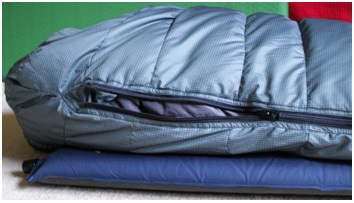 |
| Double-faced zipper – very useful for keeping thermal comfort during warmer nights |
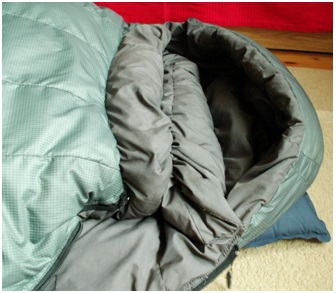 |
| Sleeping bag hood - adjustable compartment to keep head warm and reduce heat loss |
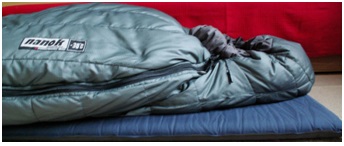 |
| Sleeping bag loft - height that reach the bag itself after pulling out off compressing sack |
 |
| Sleeping bag with longitudinal sewing chamber system over shoulder area helps to keep the down filling at the same place |
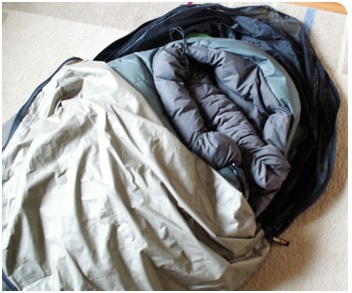 |
| Sleeping bag, bivi-sack - great combination to keep body warm during cold nights or rain |
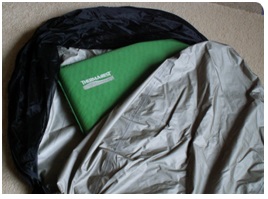 |
| Bivi sack and sleeping mat - it is better to put a mat in the sack to keep it under the body |
| The following systems are used for the down sleeping bags |
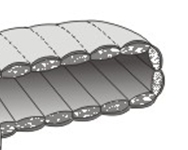 |
| System H – used for summer sleeping bags; chambers are divided by short walls |
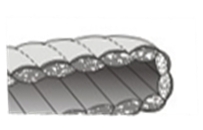 |
| System V – used in winter sleeping bags, when chambers are sewed next to each other in a V shape |
 |
| System of trapeze chambers – a very similar way of construction, but instead of chambers of V shape chambers are chambers of a trapezium shape |
 |
